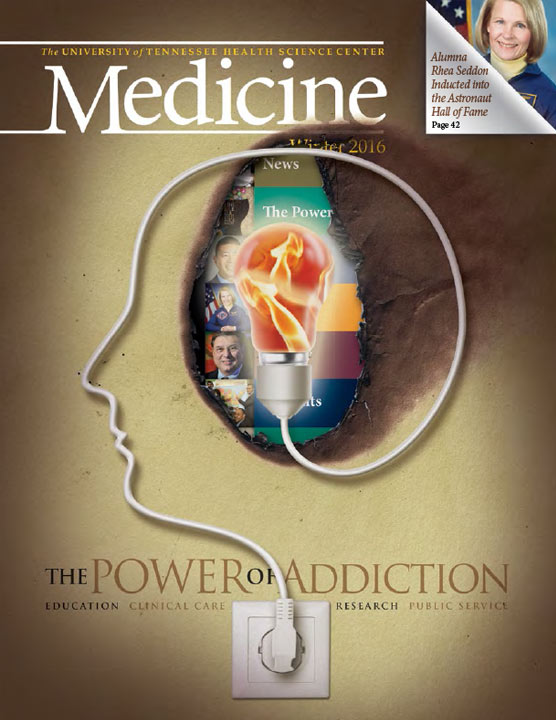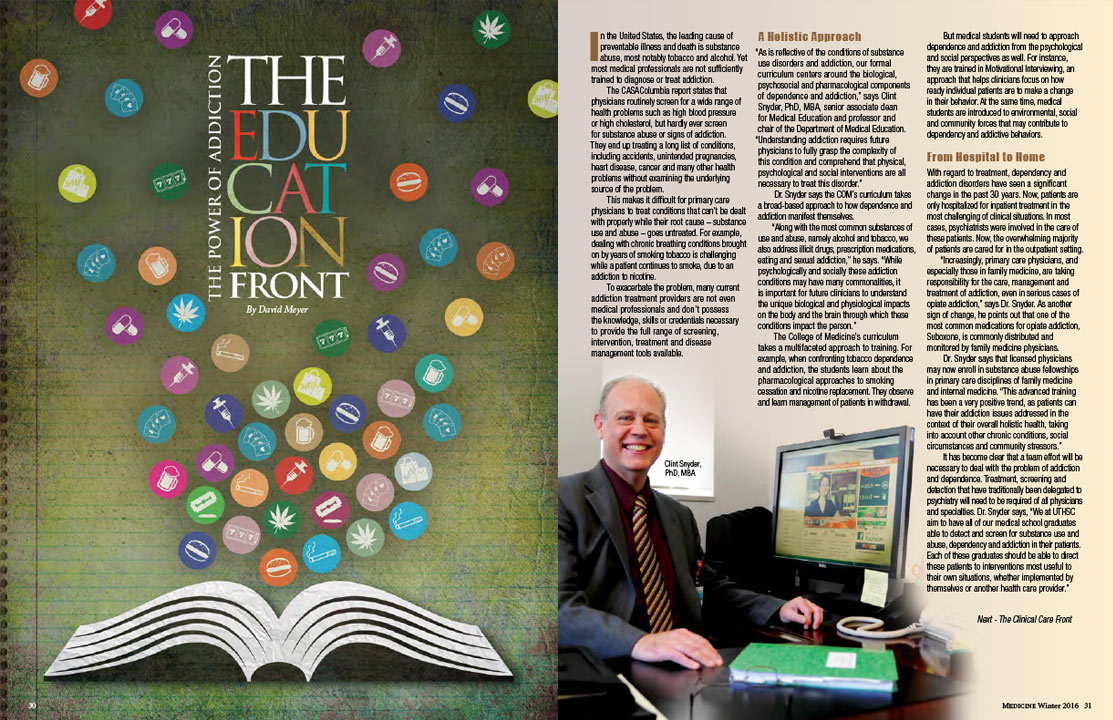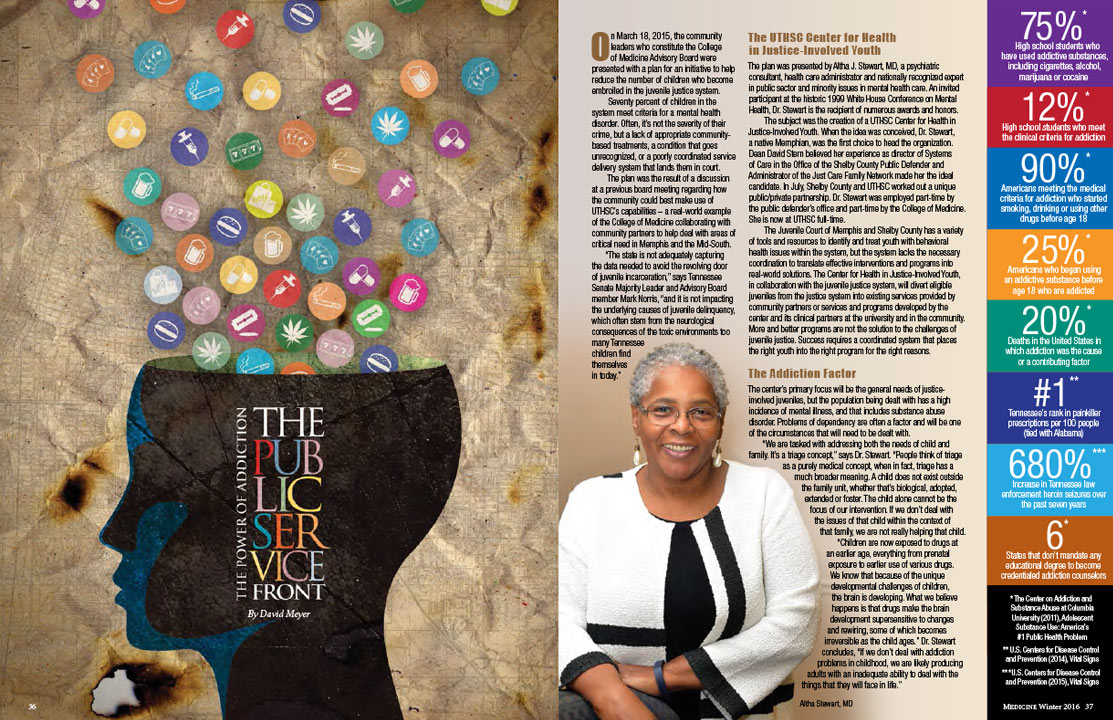The Power of Addiction
Education • Clinical Care • Research • Public Service
by David Meyer, Medicine Magazine, Winter 2016
|
Addiction can be an overwhelming force, and the statistics it produces are daunting and dismaying.
A 2012 report from the National Center on Addiction and Substance Abuse at Columbia University (CASAColumbia) reveals that addiction and risky use of tobacco, alcohol and other drugs account for the largest preventable and most costly health problems facing the country – responsible for more than 20 percent of deaths in the United States, causing or contributing to more than 70 other conditions requiring medical care, and accounting for one third of all hospital inpatient costs. The report also states that while 16 percent of the U.S. population suffers from addiction, 90 percent of them get no treatment at all. Substance addictions are huge problems, but behaviors can also become addictions. Eating, gambling, internet use and a myriad of other activities can all become compulsive. The roots of addiction can be physical, psychological, or a combination of factors. The problem addiction presents is complex and expansive, and we need a multifaceted andunified response to meet the challenge. For this reason, the College of Medicine is bringing its entire arsenal to bear – the four pillars of the UTHSC mission. On the education front, we’re training new recruits – preparing the next generation of physicians to treat dependency in an environment where addiction is no longer the sole domain of psychiatry, and hospitalization isn’t the only path. On the clinical care front, we’re growing our army. We’re enlisting other disciplines – family medicine, general internal medicine, emergency medicine, and anesthesia – to work together with psychiatry to combat the power of addiction. On the research front, we’re calling upon our veterans to organize existing “pockets of expertise,” and in the process, bring in new resources to aid us in the conflict. On the public service front, we’re organizing our troops – serving as the hub of a team effort to assure that all community resources are being utilized to help at-risk youth who are in danger of being harmed rather than helped by the justice system. It’s only through innovation, inspiration and collaboration that we can carry out our mission to confront the power of addiction. (Below is the second of three articles from the feature section)
The Power of Addiction: The Education Front
In the United States, the leading cause of preventable illness and death is substance abuse, most notably tobacco and alcohol. Yet most medical professionals are not sufficiently trained to diagnose or treat addiction. The CASAColumbia report states that physicians routinely screen for a wide range of health problems such as high blood pressure or high cholesterol, but hardly ever screen for substance abuse or signs of addiction. They end up treating a long list of conditions, including accidents, unintended pregnancies, heart disease, cancer and many other health problems without examining the underlying source of the problem. This makes it difficult for primary care physicians to treat conditions that can’t be dealt with properly while their root cause – substance use and abuse – goes untreated. For example, dealing with chronic breathing conditions brought on by years of smoking tobacco is challenging while a patient continues to smoke, due to an addiction to nicotine. To exacerbate the problem, many current addiction treatment providers are not even medical professionals and don’t possess the knowledge, skills or credentials necessary to provide the full range of screening, intervention, treatment and disease management tools available. A Holistic Approach “As is reflective of the conditions of substance use disorders and addiction, our formal curriculum centers around the biological, psychosocial and pharmacological components of dependence and addiction,” says Clint Snyder, PhD, MBA, senior associate dean for Medical Education and professor and chair of the Department of Medical Education. “Understanding addiction requires future physicians to fully grasp the complexity of this condition and comprehend that physical, psychological and social interventions are all necessary to treat this disorder.” Dr. Snyder says the COM’s curriculum takes a broad-based approach to how dependence and addiction manifest themselves. “Along with the most common substances of use and abuse, namely alcohol and tobacco, we also address illicit drugs, prescription medications, eating and sexual addiction,” he says. “While psychologically and socially these addiction conditions may have many commonalities, it is important for future clinicians to understand the unique biological and physiological impacts on the body and the brain through which these conditions impact the person.” The College of Medicine’s curriculum takes a multifaceted approach to training. For example, when confronting tobacco dependence and addiction, the students learn about the pharmacological approaches to smoking cessation and nicotine replacement. They observe and learn management of patients in withdrawal. But medical students will need to approach dependence and addiction from the psychological and social perspectives as well. For instance, they are trained in Motivational Interviewing, an approach that helps clinicians focus on how ready individual patients are to make a change in their behavior. At the same time, medical students are introduced to environmental, social and community forces that may contribute to dependency and addictive behaviors. From Hospital to Home With regard to treatment, dependency and addiction disorders have seen a significant change in the past 30 years. Now, patients are only hospitalized for inpatient treatment in the most challenging of clinical situations. In most cases, psychiatrists were involved in the care of these patients. Now, the overwhelming majority of patients are cared for in the outpatient setting. “Increasingly, primary care physicians, and especially those in family medicine, are taking responsibility for the care, management and treatment of addiction, even in serious cases of opiate addiction,” says Dr. Snyder. As another sign of change, he points out that one of the most common medications for opiate addiction, Suboxone, is commonly distributed and monitored by family medicine physicians. Dr. Snyder says that licensed physicians may now enroll in substance abuse fellowships in primary care disciplines of family medicine and internal medicine. “This advanced training has been a very positive trend, as patients can have their addiction issues addressed in the context of their overall holistic health, taking into account other chronic conditions, social circumstances and community stressors.” It has become clear that a team effort will be necessary to deal with the problem of addiction and dependence. Treatment, screening and detection that have traditionally been delegated to psychiatry will need to be required of all physicians and specialties. Dr. Snyder says, “We at UTHSC aim to have all of our medical school graduates able to detect and screen for substance use and abuse, dependency and addiction in their patients. Each of these graduates should be able to direct these patients to interventions most useful to their own situations, whether implemented by themselves or another health care provider.” (Below is the fourth of four articles from the feature section)
The Power of Addiction: The Public Service Front
On March 18, 2015, the community leaders who constitute the College of Medicine Advisory Board were presented with a plan for an initiative to help reduce the number of children who become embroiled in the juvenile justice system. Seventy percent of children in the system meet criteria for a mental health disorder. Often, it’s not the severity of their crime, but a lack of appropriate community-based treatments, a condition that goes unrecognized, or a poorly coordinated service delivery system that lands them in court. The plan was the result of a discussion at a previous board meeting regarding how the community could best make use of UTHSC’s capabilities – a real-world example of the College of Medicine collaborating with community partners to help deal with areas of critical need in Memphis and the Mid-South. “The state is not adequately capturing the data needed to avoid the revolving door of juvenile incarceration,” says Tennessee Senate Majority Leader and Advisory Board member Mark Norris, “and it is not impacting the underlying causes of juvenile delinquency, which often stem from the neurological consequences of the toxic environments too many Tennessee children find themselves in today.” The UTHSC Center for Health in Justice-Involved Youth The plan was presented by Altha J. Stewart, MD, a psychiatric consultant, health care administrator and nationally recognized expert in public sector and minority issues in mental health care. An invited participant at the historic 1999 White House Conference on Mental Health, Dr. Stewart is the recipient of numerous awards and honors. The subject was the creation of a UTHSC Center for Health in Justice-Involved Youth. When the idea was conceived, Dr. Stewart, a native Memphian, was the first choice to head the organization. Dean David Stern believed her experience as director of Systems of Care in the Office of the Shelby County Public Defender and Administrator of the Just Care Family Network made her the ideal candidate. In July, Shelby County and UTHSC worked out a unique public/private partnership. Dr. Stewart was employed part-time by the public defender’s office and part-time by the College of Medicine. She is now at UTHSC full-time. The Juvenile Court of Memphis and Shelby County has a variety of tools and resources to identify and treat youth with behavioral health issues within the system, but the system lacks the necessary coordination to translate effective interventions and programs into real-world solutions. The Center for Health in Justice-Involved Youth, in collaboration with the juvenile justice system, will divert eligible juveniles from the justice system into existing services provided by community partners or services and programs developed by the center and its clinical partners at the university and in the community. More and better programs are not the solution to the challenges of juvenile justice. Success requires a coordinated system that places the right youth into the right program for the right reasons. The Addiction Factor The center’s primary focus will be the general needs of justice-involved juveniles, but the population being dealt with has a high incidence of mental illness, and that includes substance abuse disorder. Problems of dependency are often a factor and will be one of the circumstances that will need to be dealt with. “We are tasked with addressing both the needs of child and family. It’s a triage concept,” says Dr. Stewart. “People think of triage as a purely medical concept, when in fact, triage has a much broader meaning. A child does not exist outside the family unit, whether that’s biological, adopted, extended or foster. The child alone cannot be the focus of our intervention. If we don’t deal with the issues of that child within the context of that family, we are not really helping that child. “Children are now exposed to drugs at an earlier age, everything from prenatal exposure to earlier use of various drugs. We know that because of the unique developmental challenges of children, the brain is developing. What we believe happens is that drugs make the brain development supersensitive to changes and rewiring, some of which becomes irreversible as the child ages.” Dr. Stewart concludes, “If we don’t deal with addiction problems in childhood, we are likely producing adults with an inadequate ability to deal with the things that they will face in life.” |



